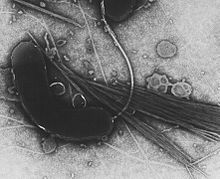Cholera
![]()
This article describes the disease. For the vegetable cake, see cholera (dish), for the body juice cholera, see gall.
Cholera ('bile flow', name for 'diarrhoeal disease', from Greek χολή cholḗ 'bile'), also cholera asiatica (Asian cholera), bilious diarrhoea (formerly also bilious dysentery), is a severe bacterial infectious disease, predominantly of the small intestine, caused by the bacterium Vibrio cholerae. Infection usually occurs through contaminated drinking water or infected food. The bacteria can cause extreme diarrhea (with "rice water stools") and severe vomiting (vomiting diarrhea), which can lead to exsiccosis due to electrolyte loss with hypothermia and collapse. Although most infections (about 85 percent) are asymptomatic, the lethality at onset is between 20 and 70 percent if untreated.
Cholera endemic to East Asia ("Cholera asiatica", "Asian cholera", "cholera morbus") probably occurred on the Indian subcontinent (starting from the Ganges delta) for several centuries in the form of localised epidemics, but was unknown on other continents. The first pandemic occurred in the period 1817 to 1824 and affected parts of Asia as well as East Africa and Asia Minor, and subsequently Russia and Europe. In 1830 it occurred in eastern Galicia and Hungary, and in June 1831 in Vienna. The first cases in Germany occurred in 1831, and the 1854 proof by the physician John Snow that a cholera epidemic in the London district of Soho was linked to contaminated drinking water is considered the birth of modern epidemiology. The cholera epidemic of 1892, which killed over 8600 people in Hamburg, is considered one of the last severe cholera epidemics on the European continent. In the cholera epidemic since 2017 in Yemen, there have been (as of April 2019) over 1.7 million suspected cases and nearly 3500 confirmed deaths.
Vibrio cholerae, the causative agent of cholera, was described - unnoticed by the public - by Filippo Pacini in 1854 and discovered by Robert Koch in 1883 in the intestines of people who had died of cholera. Koch was able to prove that the pathogen, which he called "comma bacterium", is excreted by germ carriers and can spread in water. Also in 1854, the Catalan Joaquim Balcells i Pascual described the pathogen, and in 1856 probably the two Portuguese António Augusto da Costa Simões and José Ferreira de Macedo Pinto.
The disease can occur epidemically and is notifiable in Germany and Austria; the following must be reported by name: suspected illness, illness, death, in Germany also the detection of the pathogen. In Switzerland, sick, infected and exposed persons must be reported in an identifiable manner.
.PNG)
Cholera prevalence in the world (as of 2004)
Pathogen
→ Main article: Vibrio cholerae
Cholera is caused by the bacterial species Vibrio cholerae, whose exotoxin (the cholera toxin) leads to severe, rice-water-like diarrhea (almost liquid like water with a white-cloudy coloration) with great fluid loss.
The pathogen was first described by Filippo Pacini in 1854 as a curved, comma-shaped and highly motile bacterium. John Snow also recognized in 1854 that the prevailing cholera in London was not spread by vapours (miasmas), as was generally assumed at the time. In 1884, Robert Koch, together with Bernhard Fischer and Georg Gaffky, grew the pathogen in pure culture in India from the intestines of deceased patients.
Recent evidence also showed that the ultimate disease-causing (pathogenic) cholera toxin is expressed by a DNA segment of Vibrio cholerae originally derived from a bacteriophage of the species Vibrio virus CTXphi.

Cholera bacteria in the electron microscope

Cholera bacterium O395 wt wild type in electron microscope
Occurrence
Cholera often occurs in countries where drinking water and sewage systems are not separated and therefore drinking water is often contaminated with cholera pathogens. These pathogens are found mainly in faeces and in river and sea water into which faeces are discharged. In addition, fish and other food from rivers and the sea can be contaminated with cholera pathogens.
In industrialised countries, waterworks and sewage treatment plants ensure a sufficient supply of hygienically safe drinking water for the population, so that cases of cholera are rare.
Questions and Answers
Q: What is cholera?
A: Cholera is an infectious disease caused by the bacterium Vibrio cholerae. It infects the small intestine.
Q: How many types of Vibrio cholera bacteria are there?
A: There are many types (strains) of the Vibrio cholera bacteria.
Q: What are some common symptoms of cholera?
A: The most common symptom is large amounts of watery diarrhea. In the worst cases, diarrhea can be so bad that people can die in a few hours from dehydration.
Q: When was cholera first written about?
A: Writings about cholera (written in Sanskrit) have been found from the 5th century BC.
Q: How many people get and die from cholera every year?
A: Estimates from 2010 say that between 3 million and 5 million people get cholera every year, and 58,000–130,000 people die from the disease every year.
Q: Is it considered a pandemic today?
A: Yes, today, cholera is considered a pandemic.
Q: Who does it affect most commonly?
A: Cholera is most common in developing countries, especially in children.
Search within the encyclopedia